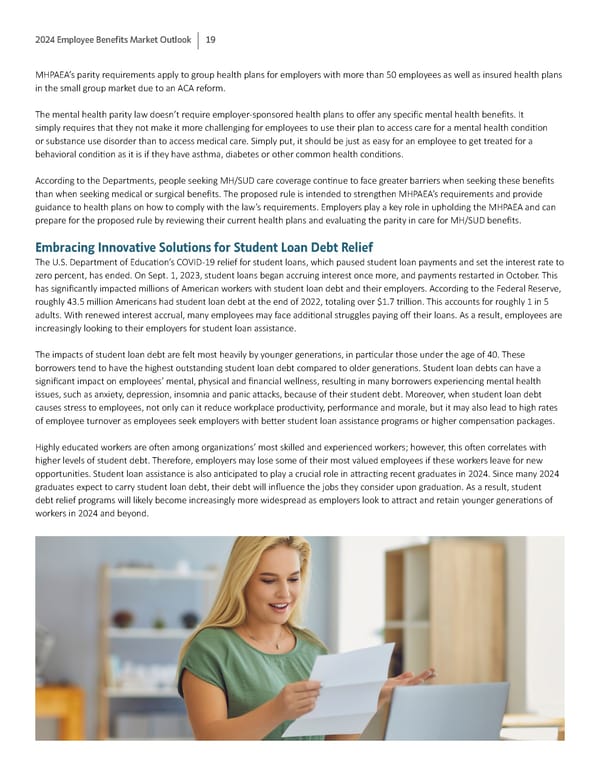2024 Employee Benefits Market Outlook 19 MHPAEA’s parity requirements apply to group health plans for employers with more than 50 employees as well as insured health plans in the small group market due to an ACA reform. The mental health parity law doesn’t require employer-sponsored health plans to o昀昀er any speci昀椀c mental health bene昀椀ts. It simply requires that they not make it more challenging for employees to use their plan to access care for a mental health condi琀椀on or substance use disorder than to access medical care. Simply put, it should be just as easy for an employee to get treated for a behavioral condi琀椀on as it is if they have asthma, diabetes or other common health condi琀椀ons. According to the Departments, people seeking MH/SUD care coverage con琀椀nue to face greater barriers when seeking these bene昀椀ts than when seeking medical or surgical bene昀椀ts. The proposed rule is intended to strengthen MHPAEA’s requirements and provide guidance to health plans on how to comply with the law’s requirements. Employers play a key role in upholding the MHPAEA and can prepare for the proposed rule by reviewing their current health plans and evalua琀椀ng the parity in care for MH/SUD bene昀椀ts. Embracing Innovative Solutions for Student Loan Debt Relief The U.S. Department of Educa琀椀on’s COVID-19 relief for student loans, which paused student loan payments and set the interest rate to zero percent, has ended. On Sept. 1, 2023, student loans began accruing interest once more, and payments restarted in October. This has signi昀椀cantly impacted millions of American workers with student loan debt and their employers. According to the Federal Reserve, roughly 43.5 million Americans had student loan debt at the end of 2022, totaling over $1.7 trillion. This accounts for roughly 1 in 5 adults. With renewed interest accrual, many employees may face addi琀椀onal struggles paying o昀昀 their loans. As a result, employees are increasingly looking to their employers for student loan assistance. The impacts of student loan debt are felt most heavily by younger genera琀椀ons, in par琀椀cular those under the age of 40. These borrowers tend to have the highest outstanding student loan debt compared to older genera琀椀ons. Student loan debts can have a signi昀椀cant impact on employees’ mental, physical and 昀椀nancial wellness, resul琀椀ng in many borrowers experiencing mental health issues, such as anxiety, depression, insomnia and panic a琀琀acks, because of their student debt. Moreover, when student loan debt causes stress to employees, not only can it reduce workplace produc琀椀vity, performance and morale, but it may also lead to high rates of employee turnover as employees seek employers with be琀琀er student loan assistance programs or higher compensa琀椀on packages. Highly educated workers are o昀琀en among organiza琀椀ons’ most skilled and experienced workers; however, this o昀琀en correlates with higher levels of student debt. Therefore, employers may lose some of their most valued employees if these workers leave for new opportuni琀椀es. Student loan assistance is also an琀椀cipated to play a crucial role in a琀琀rac琀椀ng recent graduates in 2024. Since many 2024 graduates expect to carry student loan debt, their debt will in昀氀uence the jobs they consider upon gradua琀椀on. As a result, student debt relief programs will likely become increasingly more widespread as employers look to a琀琀ract and retain younger genera琀椀ons of workers in 2024 and beyond.
 2024 Employee Benefits Market Outlook Page 18 Page 20
2024 Employee Benefits Market Outlook Page 18 Page 20